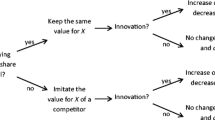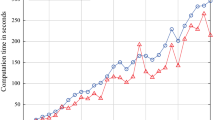Abstract
In technology-intensive markets, it is a common strategy for companies to develop long-term multiple generation product lines instead of releasing consecutive single products. Even though this strategy is more profitable than sequentially introducing single product generations, it can also result in inter-product line cannibalization. Cannibalization of multiple-generation product lines is a complex problem that needs to be taken into account at the early product line planning stage in order to sustain long-term profitability. In this paper, we propose an agent-based model that can simulate the potential cannibalization scenarios within a multiple-generation product line. We view a multiple-generation product line (MGPL) as complex adaptive system where each product generation in the MGPL adjusts its sales price over time based on the shifts in the market demand. The proposed model provides insights into how various pricing strategies impact the overall lifecycle profitability of MGPL and can be used to assist companies in developing appropriate dynamic pricing strategies at the early product line planning stages.
Similar content being viewed by others
References
Arslan H., Kachani S. & Shmatov K. (2009). Optimal product introduction and life cycle pricing policies for multiple product generations under competition. Journal of Revenue Management, Vol 8(5):438–451.
Bardhan A.K. & Chanda, U. (2008). A model for first and substitution adoption of successive generations of a product. International Journal of Modeling and Simulation, Vol. 28(4): 487–494.
Bonabeau E. (2002). Agent-based modeling: methods for first and substitution for simulating human systems. Proceedings of the National Academy of Sciences. Vol. 99: 7280–7287.
Chen J. & Chang C. (2013). Dynamic pricing for new and remanufactures products in a closed-loop supply chain. International Journal of Production Economics, Vol. 146: 153–160.
Danaher P.T., Bruce G.S., Putsis H. & Putsis W.P. (2001). Marketing-Mix variables and the diffusion of successive generations of a technological innovation. Journal of Marketing Research, Vol. 38(4): 501–514.
Desai P. S. (2001). Quality segmentation in spatial markets: When does cannibalization affect product line design. Marketing Science. Vol. 20(3): 265–283.
Druel C. T., Schmidt G. M. & Souza G. C. (2009). The optimal pace pf product updates. European Journal of Operational Research, Vol 192: 621–633.
Dobson G. & Kalish S. (1988). Positioning and pricing a product line. Marketing Science. Vol. 7(2): 107–125.
Edelheit L.S. (2004). Perspective on GE research and development. Research Technology Management. Vol. 47(1): 49–55.
Fruchter G. E., Fligler A. & Winer R. S. (2006). Optimal product line design: genetic algorithm approach to mitigate cannibalization. Journal of Optimization Theory and Applications, Vol 131(2): 227–244.
Gallego G. & Wang R. (2014). Multiproduct price optimization and competition under nested logit model with product-differentiated price sensitivities. Operations Research. Vol. 62(2): 450–461.
Harvey M.G. & Kerin R.A. (1979). Diagnosis and management of the product cannibalism syndrome. University of Michigan Business Review. Vol. 31(6): 18–29.
Hernandez C. & Frances P. H. (2009). The launch timing of new and dominant multi-generation technologies: An application to the video-game systems market. ERIM Report Series Research in Management. Available online: http://repub.eur.nl/pub/19670
Holland J. (1992). Complex adaptive systems. Daedalus, A New Era in Computation. Vol. 121(1): 17–30.
Huang C.Y. & Tzeng G.H. (2008). Multiple generation product life cycle predictions using a novel two-stage fuzzy piecewise regression analysis method. Technology Forecasting & Social Change. Vol. 75: 12–31.
Jia J. & Zhang J. (2013). Dynamic ordering and pricing strategies in a two-tier multi-generation durable goods supply chain. International Journal of Production Economics, Vol. 144: 135–142.
Jiang Z. & Jain D. (2012). A generalized norton-bass model for multigeneration diffusion. Management Science. Vol. 58(10): 1887–1897.
Kim N., Srivastava R. K. & Hand J. K. (2001). Consumer decision making in a multi-generational choice set context. Journal of Business Research, Vol. 53: 123–136.
Krankel R. M., Duenyas, I. & Kapuscinski, R. (2006). Timing successive product introductions with demand diffusion and stochastic technology improvement. Manufacturing and Service Operations Managament. Vol 8(2): 119–135.
Kuo C. & Huang K.. (2012). Dynamic pricing of limited inventories for multi-generation products. European Journal of Operations Research. Vol. 217(2):394–403.
Li H. & Graves S.C. (2012). Pricing decisions during inter-generational product transition. Productions and Operations Management. Vol. 21(1): 14–28.
Lin C. & Okudan G.E. (2011). State-dependent behavioral models for designing a multiple-generation product line. Industrial Engineering Research Conference. Reno. NV.
Lin C. & Okudan G.E. (2012). Application of dynamic state variable models for multiple-generation product lines with cannibalization across generations. Proceedings of the ASME International Design Engineering Technical Conferences & Computers and Information in Engineering Conference, Chicago, IL.
Lin C., Kilicay-Ergin N. & Okudan G.E. (2012). Agent-based modeling of dynamic pricing scenarios to optimize multiple-generation product lines with cannibalization. Proceedings of the Complex Adaptive Systems Conference, Chicago IL, Procedia Computer Science, Vol 6: 311–316.
Lin, C. & Okudan G.E. (2013).Planning for multiple-generation product lines using dynamic state variable models with data input from similar products. Expert Systems with Applications, 40:2013–2022.
Lin C. & Okudan Kremer G. E. (2014). Strategic decision making for multiple-generation product lines using dynamic state variable models: The cannibalization case. Computers in Industry, 65: 79–90.
Macy M. W. & Willer R. (2002). From factors to actors: computational sociology and agent-based modeling. Annual Review of Sociology. Vol. 28: 143–166.
Mahajan V. & Muller E. (1996). Timing, diffusion, and substitution of successive generations of technological innovations: The IBM mainframe case. Technological Forecasting and Social Change. Vol. 51: 109–132.
Mazumdar T., Sivakumar K. & Wilemon D. (1996). Launching new products with cannibalization potential: an optimal timing framework. Journal of Marketing Theory and Practice, Vol. 4(4): 83–93
Meredith L. & Maki D. (2001). Product cannibalization and the role of prices. Applied Economics, Vol. 33(14): 1785–1793.
Morgan L.O., Morgan R. M., & Moore W.L. (2001). Quality and time to market trade-offs when there are multiple product generations. Manufacturing & Service Operations Management. Vol. 3(2): 89–104.
Murphy D. (2011). Windows 7 finally beats Windows XP’s U.S. desktop share. Pcmag.com. available via: http://www.pcmag.com/article2/0,2817,2383347,00.asp. Cited December 2014.
Nagle T.T., Hogan J. E. & Zale J. (2010). The Strategy and Tactics of Pricing: A Guide to Growing More Profitability (5th ed.). Prentice Hall, New Jersey.
Norton J. A. & Bass F. M. (1987). A diffusion theory model of adoption and substitution for successive generations of high-technology products. Management Science. Vol. 33(9): 1069–1086.
Ofek E. & Savary M. (2003). R&D, Marketing and the success of next-generation products. Marketing Science. Vol. 22(3): 355–370.
Schon C. (2010). On the optimal product line selection problem with price discrimination. Management Science. Vol. 56(5): 896–902.
Srinivasan S. R., Ramakrishnan S. & Grassman S. E. (2005). Identifying the effects of cannibalization on the product portfolio. Marketing Intelligence & Planning. Vol. 4(5): 359–371.
Author information
Authors and Affiliations
Corresponding author
Additional information
Nil Kilicay-Ergin is Assistant Professor of Systems Engineering at Penn State University’s Great Valley School of Graduate Professional Studies. Prior to joining Penn State University, she worked as a Research Assistant Professor within the Research Institute for Manufacturing and Engineering Systems (RIMES) at the University of Texas at El Paso where she taught for the systems engineering graduate program and served on industry funded research contracts. She was also a Postdoctoral Fellow at Missouri University of Science & Technology. Nil Ergin received her Ph.D. in systems engineering and M.S. in Engineering Management from the Missouri University of Science & Technology. She also holds a B.S. degree in Environmental Engineering from Istanbul Technical University, Turkey. Her research interests include model-based systems engineering, system of systems engineering, complex adaptive systems, and multi-agent systems. She is a member of INCOSE and IEEE.
Chun-yu Lin received his Ph.D. from the Department of Industrial and Manufacturing Engineering at The Pennsylvania State University in 2012. His research interests focus on developing methods to solve product design and development problems. Most recently, he has made significant contributions to multiple generation product line literature by proposing to use dynamic state variable methods in generation introduction timing decisions.
Gul E. Okudan Kremer is a Professor of engineering design and industrial engineering at The Pennsylvania State University. She received her Ph.D. from the Department of Engineering Management and Systems Engineering of Missouri University of Science & Technology in 1997. Her research focuses on development and application of decision making methods and design theory to improve products and systems. She has co-authored over 250 peer-reviewed papers to date and received six best paper awards. She has been also a National Research Council — US AFRL Summer Faculty Fellow for the Human Effectiveness Directorate for 2002, 2003 and 2004, and a Fulbright Scholar (2010–2011). She is a senior member of IIE and a fellow of ASME She is currently serving as a Program Director for Division of Undergraduate Education of the National Science Foundation.
Rights and permissions
About this article
Cite this article
Kilicay-Ergin, N., Lin, Cy. & Okudan, G.E. Analysis of dynamic pricing scenarios for multiple-generation product lines. J. Syst. Sci. Syst. Eng. 24, 107–129 (2015). https://doi.org/10.1007/s11518-015-5264-2
Published:
Issue Date:
DOI: https://doi.org/10.1007/s11518-015-5264-2




